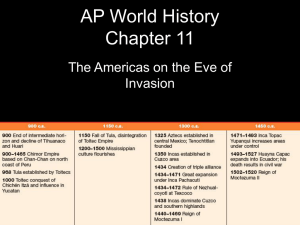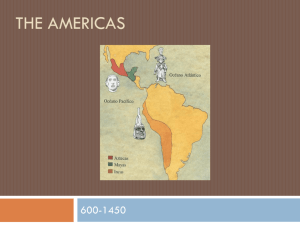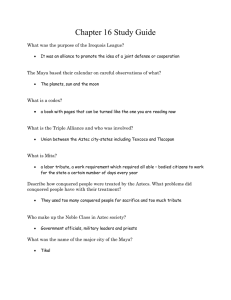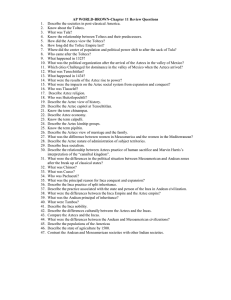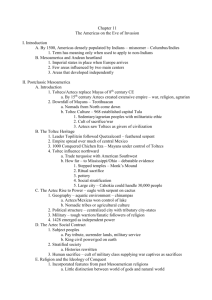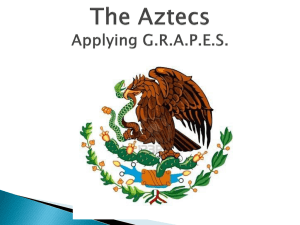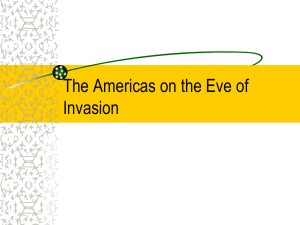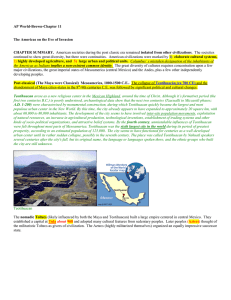CHAPTER 11 The Americas on the eve of invasion
advertisement
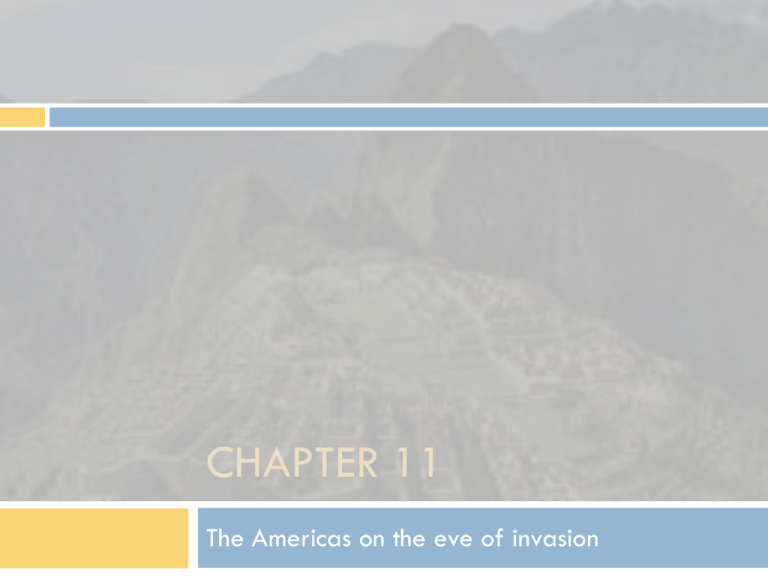
CHAPTER 11 The Americas on the eve of invasion Objective How did the environment influence the development of societies in the Americas and how does that compare with the empires we have discussed so far? 2500s BCE-400 BCE 300s-900s CE 900s-1200s CE 1100s-1500s CE 1300s- 1500s CE Olmec Mayas Toltecs Incas Aztecs Olmecs (800 BCE) River-valley equivalent Adopt agriculture and cultivate corn and potatoes Lack system of writing Create massive architecture Domestication of dogs, turkeys and guinea pigs Maya (400-700CE) Polytheistic Blood sacrifice Intellectual Achievements astronomy, calendric systems, hieroglyphic writing, ceremonial architecture, and masonry without metal tools Toltecs (900-1150 CE) Adoption of earlier agricultural practices Human sacrifice Viewed as givers of civilization by later tribes (inaccurate) Legend of Topiltzin & Quetzalcoatl Possible contact with SW American Indians Aztecs (1300s – mid 1521) Aggressive & warlike people Continue practice of human sacrifice Creation of divine kingship Region trade and tribute from conquered peoples Unable to remove women from economic activity Provided necessary labor for food production Due to lack of animal domestication or the wheel Women were treated better (finally) Empire conquered by the Spanish conquistador Hernan Cortes Aztec Religion Polytheistic religion 128 gods Fertility, agriculture, creation, war, sacrifice Still address the major theological questions of human existence Cult of Human Sacrifice Took a tradition and changed it More and different Aztec Agriculture Chinampas, man-made floating islands High yield farming Video Most of the 150,000 -200,000 people were not food producers Maize, beans and crops Aztec Social Structures Calpulli: Kin groups or clans Historically As the Aztecs grew in power the Calpulli changed Became 7 residential groups Social stratification Some Calpulli were more important than others Within the Calpulli itself, some families were more important than others Social separation was very apparent and widened as the empire grew Tenochtitlan (Before and After) Incas (1300’s – 1533) Influenced by earlier Andean cultures, but not by Olmecs/Toltecs Earlier societies known as intermediate horizon states Incan Culture Culture of war and conquest Cult of the Ancestor split inheritance Power given to one heir, wealth to remainder of male offspring Wealth used to support deceased in afterlife New ruler compelled to acquire new wealth through conquest to ensure his one care in afterlife Gender-specific roles in the home and in society Emphasis on cooperation Inheritance passed through gender Father to son, Mother to daughter How the Inca’s maintained control Development of regional government and state bureaucracy Land and labor from conquered people, rather than monetary tribute Considerate of local customs and traditions Creation of complex system of roads (2500 miles) More complex system of trade than Aztecs No written language Development system of Quipu: knotted counting Inca agricultural Development of agricultural terraces on mountainsides Similar to Aztec chinampas Incan Downfall Weakened by alliances and arranged royal marriages Centralization was not as strong Empire conquered by Spanish conquistador Francisco Pizzaro Kidnapped Killed Him the Inca Comparing Incas and Aztecs Both built on previous civilizations Both represented success at imperial and military organization Both created by the conquest of sedentary agricultural people and the extraction of tribute and labor from them Both older kinship-based institutions changed with the rise in nobility Both recognized local ethnic groups and powers Aztec trade and markets more developed Exit How did the environment influence the development of societies in the Americas and how does that compare with the empires we have discussed so far? Answer this please in your check for understanding worksheet
